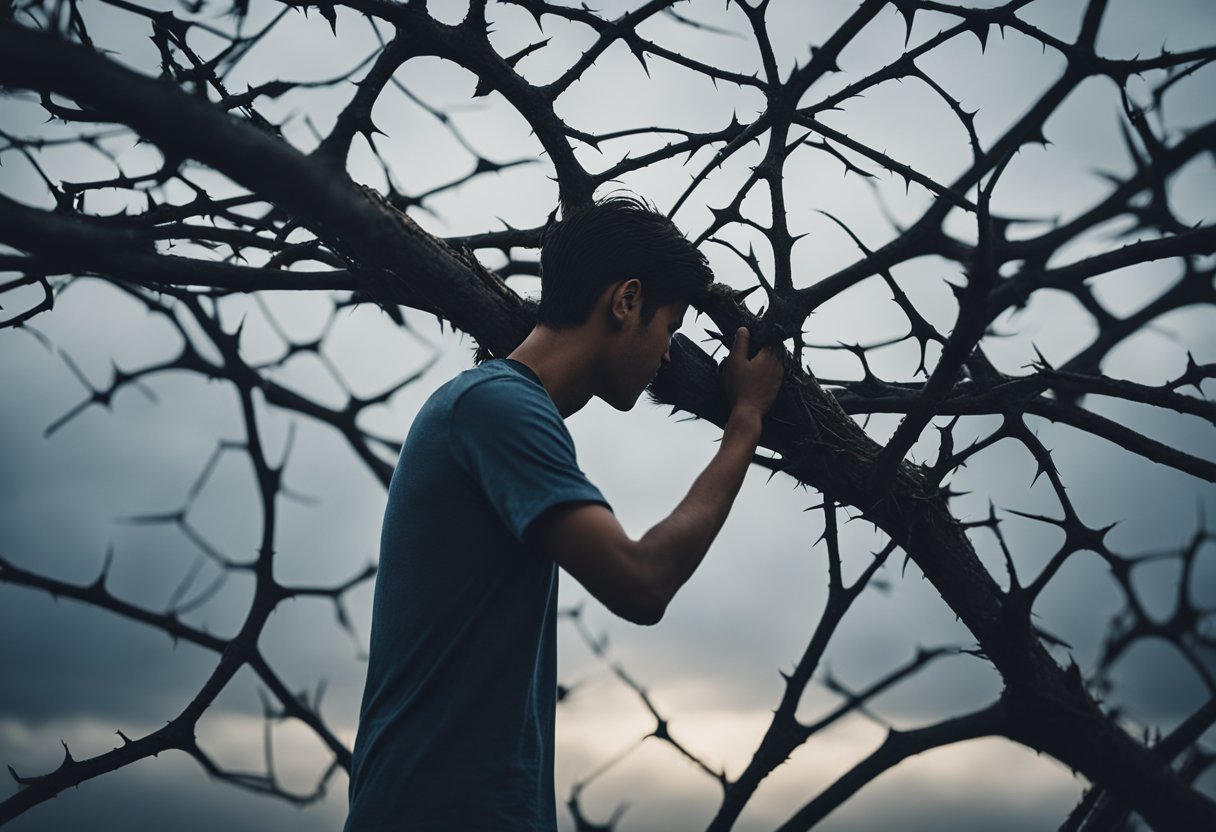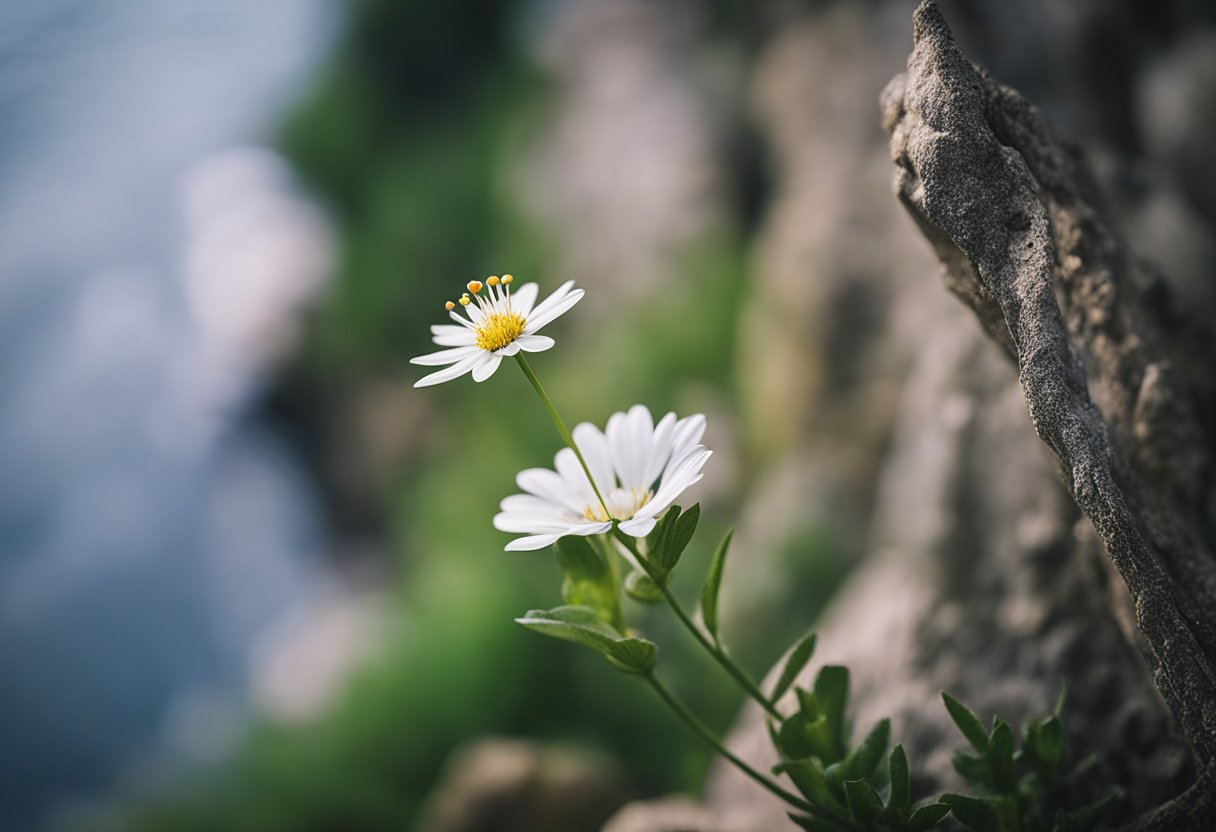
Loving someone who inflicts pain, be it emotional or physical, can be likened to a dance where the music is an enigmatic mix of heartache and devotion. It is a perplexing human experience, where the heart seems to triumph over logical reasoning. Despite the hurt, the affection lingers, creating a complex tangle of emotions that is difficult to unravel. This endurance often stems from deep-seated attachment and a powerful hope that things will improve with time. It is certainly not easy “loving someone who hurts me”.

Individuals caught in this emotional whirlwind sometimes find themselves walking a fine line between maintaining love and preserving self-respect. Setting boundaries becomes essential in safeguarding one’s emotional health. While navigating these challenging relationships, external support plays a pivotal role, whether it’s through friends, family, or professional guidance, in helping one understand the dynamics at play and making decisions that lead toward healing.
Key Takeaways
- Emotional connections can make us hold onto relationships despite being hurt.
- Establishing personal boundaries is crucial for emotional safety and self-respect.
- Seeking support from others can provide clarity and facilitate the journey to healing.
The Science of Attachment: Why We Stick Around
https://www.youtube.com/watch?v=th6aJ9SnqYA&embed=true
In the puzzling world of relationships, the stickiness of emotional bonds can baffle even the wisest of love gurus. It’s not just about the heart skipping a beat or getting all gooey-eyed; the science of attachment digs deep into why humans hang on, even when love throws a mean right hook.
Emotional Rollercoasters: Understanding the Highs and Lows
When it comes to family ties or that special someone, feelings can flip faster than a pancake at a breakfast buffet. One minute, they’re on cloud nine, and the next, they’re plummeting into a valley of despair. But why? Turns out, people are wired for connection. Like moths to a flame, they’re drawn to relationships that stir up a wild carnival of emotions, feeling alive in the whirling chaos of the highs and lows.
The Love-Hurt Paradox
Seems contradictory, doesn’t it? Here they are, smart, sensible beings, yet when it comes to a toxic or even an abusive relationship, logic hops out the window. Part survival instinct, part old habits dying hard, they often cling to the familiarity of a relationship—even when it’s serving them a cocktail of misery. It’s like that age-old wisdom: better the devil you know than the devil you don’t, and sometimes that devil just happens to have a cute smile.
The Tightrope Walk: Balancing Love and Self-Respect

Navigating the challenging terrain of affections, one might find themselves in a less-than-ideal love circus. Here, the main act involves walking a tightrope between heartache and dignity. It is sure a heart-wrenching dance in the saga of ‘loving someone who hurts me’.
Identifying the Hurt
First things first, let’s spot that pesky pain. It’s as if someone decided it would be a great idea to play darts, using their emotions as the board—certainly not a recommended pastime. When love leads to hurt, it’s often not as spectacular as a cinematic heartbreak. No dramatic thunderstorms or passionate monologues, just a regular Tuesday being less than grand.
- Reasons for Hurt:
- Neglect: as common as lost socks in the laundry.
- Misunderstandings: could fill an encyclopedia.
- Broken Trust: like a vase that’s been glued back together—visible cracks.
Recognizing Harmful Patterns in Relationships
Now for the part where they become a detective in their own love life. Patterns in relationships sometimes resemble those mystery food stains on one’s shirt that appear out of nowhere—stubborn and annoyingly recurrent.
- Patterns to Watch:
- Consistent Disrespect: Pops up more than that one relative who never gets the hint to leave after a family gathering.
- Anger Mismanagement: It’s like having a blender with no lid. Contents everywhere!
- Lack of Boundaries: A fence so low, even a snail could breach it.
People might wonder, “Is this passionate tango with my partner turning into a solo resentment rumba?” At this juncture, respect starts to wave goodbye, and healing needs to be auditioned for the next lead role in one’s personal drama.
Hanging onto Hope: When It’s Helpful and When It’s Not

Hanging onto hope in a love affair that’s more ouch than smooch can be a high-stakes game of emotional poker. Knowing when to hold those hopeful hearts and when to fold them before the deck is stacked against you is crucial in the whimsical world of wooing.
Self-Reflection Time
Before one plunges into an Olympic-sized pool of hope, it’s essential to don the swim cap of self-awareness. Taking a “Me-Time-Out” offers a chance to ponder the big question: “Is this relationship my cozy blanket or a scratchy wool sweater?” If they’ve found themselves more in a tangle than a tango, it might be time to consider the possibility that change is not only necessary but could be refreshingly invigorating.
Communication in a Hurting Relationship
Conversely, good communication with a partner isn’t just about sharing memes. It’s time to employ the formidable “power of the parley.” Sitting down and having a heart-to-heart can either be the super glue that mends things or reveal that their love story is in need of a serious plot twist. Support from a partner during these chats should feel like a trusty safety net, not a lecture from someone who’s missed the point by a cosmic mile.
Boundaries: Your Emotional Safety Net
https://www.youtube.com/watch?v=tEzpiM3pV5k&embed=true
In the quest for emotional well-being, setting boundaries is like hiring bouncers for the nightclub of your heart. They ensure you’re not stuck picking up the emotional tab for someone else’s carelessness.
The Power of ‘No’: Protecting Your Heart
They say ‘no’ is a complete sentence, but when it comes to protecting one’s heart, it’s also the password to the most exclusive party in town: self-respect. A person must muster the courage to say ‘no’ to mistreatment, recognizing that every ‘no’ to negativity is a resounding ‘yes’ to their emotional security. Like a well-trained cat that refuses to perform tricks, asserting ‘no’ reflects a stance of calm and compassion toward oneself—ignoring the ill-treatment tuna that life sometimes offers.
Setting Boundaries with Someone Who Hurts You
Enacting boundaries with a hurtful other isn’t about building an emotional Berlin Wall. Instead, it’s about laying out a velvet rope—only kindness, compassion, and respect get the nod to step behind the velvet rope. “Do not cross” tape isn’t only for crime scenes but also for those trampling over one’s feelings without an invitation. When they overstep, it’s less about teaching them a lesson and more about honoring oneself. A person doesn’t need to be a gatekeeper of harsh truths but rather a curator of their emotional museum, admitting only the most thoughtful and considerate exhibits into their space.
When Love Starts to Heal

After weathering emotional storms, the sun breaks through clouds when love shifts from hurting to healing. It’s like turning a broken record into a sweet melody.
Turning the Tide: Steps to Healing in a Hurting Relationship
The first step is admitting that the love boat has hit an iceberg and everyone’s soaked. But rather than shouting for a life preserver, they opt for a more heroic route: healing together. Coaching and or therapy can be a beacon here, shining a light on hidden pain. Someone wise once said, “You’ve got to feel it to heal it,” and they weren’t wrong.
- Acknowledgment: “Hey, this hurts!” Simple but true.
- Communication: No mind reading—except in superhero comics.
- Vulnerability: Imagine wearing heart-shaped glasses.
- Action: Love is a verb, say it with flowers or apologies.
Love Rehab: Techniques for Mending the Wounds
They don’t need superhero capes, but they might require superhero-sized courage. Techniques for mending relationship wounds often blend the gentle art of patience with the bold strokes of change.
- Embracing Vulnerability: It’s like being emotionally naked but less chilly.
- Building Trust: Every “I’m sorry” and “I forgive you” sets another brick in place.
- Trauma-Informed Therapy: Dive into past hurts with someone who won’t need a lifeguard.
Remember, stitches might leave scars, but every scar tells a story of survival—just ask any brave relationship warrior.
The Power of External Support
https://www.youtube.com/watch?v=MKEi6Zr5FXE&embed=true
When love feels more like a wrestling match than a romantic dance, external support becomes the tag-team partner they never knew they needed. It’s about having those cheerleaders, those sage advisors, those who hand them tissues and the occasional ice-cream tub when the going gets tough.
Friends, Family, Life Coaches, and Therapists: Your Support Squad
Imagine their friends and family with pompoms, and life coaches and or therapists holding the strategic playbook. That’s not far off from reality. Friends offer shoulders that have unlimited cry-into capacity and possess an impressive array of distractions. From marathon movie nights to adventurous road trips, they know just how to stage a smile on their loved ones’ faces.
Family, on the other flank, tends to be the fortress of comfort food and sometimes unsolicited—but usually spot-on—advice.
Now, life coaches and or therapists, they’re the specialists with more acronyms after their names than a high-end computer. Engaging in therapy provides them a safe space to untangle feelings with someone who won’t spill their secrets at the next family BBQ. The life coaches and therapists are the MVPs for coping strategies.
Sharing Your Story: Why External Perspectives Matter
Sharing their tale isn’t just about offloading their emotional luggage; it’s also about hearing out-of-the-box insights that their love-blinded selves might have missed. A fresh perspective can be a game-changer, exposing them to new ways of thinking. Their confidants can often spot red flags from a mile away or provide the hard truths they’ve been avoiding.
By articulating their thoughts and feelings, they often unravel their own Gordian knot of emotions. It’s as though their friends and family hold up a mirror, but instead of showing them their tear-streaked faces, it reflects the choices and changes they might need to ponder.
Navigating Breakup Territory
https://www.youtube.com/watch?v=rWf0wFvsP68&embed=true
In the landscape of love, not all roads are smooth—sometimes one finds potholes of heartbreak and speed bumps of painful affection. One must recognize when the map directs toward a dead-end and muster the courage for a U-turn towards self-recovery.
When to Say Goodbye: Recognizing the Breaking Point
One may play emotional detective, trying to spot when ‘quirky’ becomes ‘contempt-worthy’ and ‘spontaneous’ turns into ‘ghostly’. Recognizing the breaking point is like realizing that their favorite sweater actually itches like a thousand ants at a picnic. They need to find the wherewithal to say, “It’s not me, it’s definitely you,” and take a step back to survey emotional damages.
- Signs of the Emotional Apocalypse:
- Sudden interest in solo karaoke nights.
- Frequent flyer miles accumulate from the distance one’s been keeping.
- One’s diary starts reading like a bad soap opera script.
The Art of Letting Go: Breaking Free from Hurtful Love
Releasing a love that wounds is akin to returning a wild animal back to the forest—it’s for the best, even if one has grown fond of its erratic behavior. Letting go doesn’t mean they’re weak; it simply means they’re strong enough not to use super glue to fix a porcelain heart that keeps shattering.
- The Emotional Tool Kit:
- Scissors for Ties that Bind: Snip, snip — and the burdensome strings of attachment fall away.
- Forgiveness Glue: Oddly doesn’t stick to the other person, but patches up one’s own soul quite nicely.
- Map of Closure: X marks the spot where one buried their “what-ifs” and “if-only,” never to be dug up again.
Finding Love After Hurt
https://www.youtube.com/watch?v=N_I2qr5ndzI&embed=true
After the storm of a painful breakup, one might think that their heart has taken an early retirement. But just like the mythical Phoenix, the ability to love can rise anew from the ashes of lost relationships.
Hope after Hurt: Opening Your Heart Again
They say that time heals all wounds, but let’s be honest—it’s also about finding someone who doesn’t bring out the need for emotional band-aids. Opening one’s heart again is akin to a trust fall; it requires the belief that this time, someone will be there to catch them. Embracing hope after being hurt is the emotional equivalent of going from Netflix binges to triathlon training: it’s a journey from comfort zone to courage.
Love Lessons: What Painful Love Teaches Us
Let’s not sugarcoat it; loving someone who’s caused pain is like touching a hot stove—educational, yet unpleasant. However, they’ve likely learned a thing or two, like how a good relationship shouldn’t feel like an episode of “Survivor.” Painful experiences in love can be transformed into a sort of emotional curriculum vitae. Each heartache teaches what to look for in the right partner and, perhaps more importantly, what red flags to sprint away from at Olympic speeds. They learn that moving forward isn’t just about finding love again, but also about armoring up with wisdom for the next romantic adventure.
Frequently Asked Questions

Navigating the choppy waters of love comes with questions, especially when sailing the seas with captains of chaos. Here are the answers to the SOS calls from the heart.
Why do they keep the flame alive for their personal emotional arsonist?
One might find themselves tethered to a relationship that burns more than it soothes because they’re hopeful that the flickers of good times will reignite. They could also feel that this fiery trial is a test of their love’s resilience.
What’s the deal with their heart acting like a boomerang, no matter how hard they throw it at the ‘hurts-a-lot’ dartboard?
Hearts have a notorious reputation for playing fetch with themselves, especially when the target is someone who has spiked their adrenaline with a blend of pain and passion. It’s a puzzling game of emotional catch and release.
Is there an off switch for caring about someone with the emotional finesse of a wrecking ball?
One might wish for an off switch, but emotions are more tangled than earphones in a pocket. The red button to cease caring often fades when mixed with memories and hope for what could be.
How can one draft an Oscar-winning screenplay for the drama ‘When Love Feels Like Stepping on Legos’?
One must simply script the highs so high and the lows so excruciating that love’s pain parallels a midnight stroll across a floor littered with Legos. Dramatic plot twist: the protagonist always goes barefoot.
Am I a magnet for emotional ouchies, or is this just an unrequited love thing?
Some might feel cursed to attract partners who serve up love with a side of ouch, but it may just be a sequence of unrequited love scenarios, where one cares more deeply than the other party. This isn’t rare, but rather a rite of passage in the world of romance.
Could my ‘Ouchie-O-Meter’ be broken, or is this just how twisted love lines read?
It’s likely not broken; it’s just that love’s graph often looks more like a lie detector test than a serene heart rate monitor. The messier the readout, the more a person is invested in the chaotic cadence of a tumultuous relationship.
 Skip to content
Skip to content
